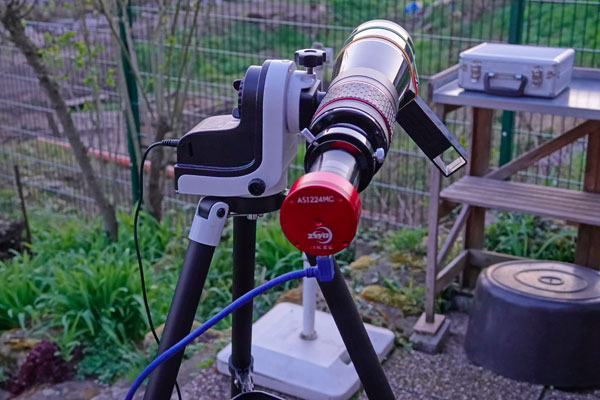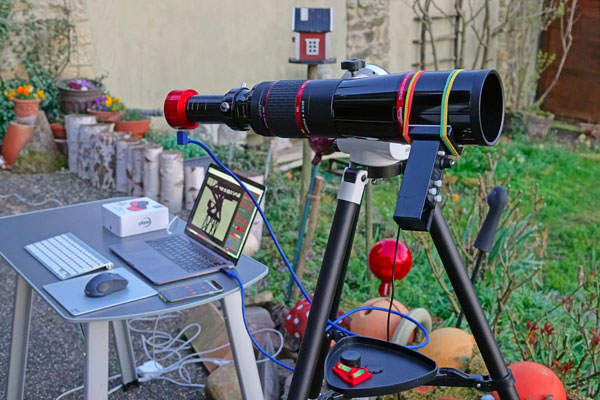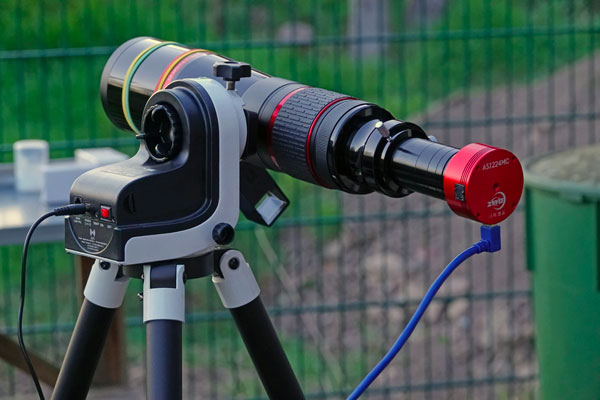Deep Sky Observations with ZWO ASI224MC 2022
Conditions | Observation Overview | Overview of the Observed Sky Objects | Remarks | References
Archive
At the beginning of April 2021, I borrowed a ZWO ASI224MC from a starfriend, and bought it from him on April 25, 2021. This camera has the same Sony sensor as my eVscope, which was one reason to borrow and buy the camera and try it out on my various telescope tubes. The other one was that I was not satisfied with my Atik Infinity camera after several tests in early 2021, especially with its sensitivity. It was said that modern CMOS cameras are more sensitive than CCD cameras like the Atik Infinity, which in turn is said to have better dynamic range. Reasons enough to test this camera! The following tests took place in the beginning of 2022.
Update: I bought the ASI224MC from a starfriend on April 25, 2021 and I sold it again in mid-April 2022.
Conditions
Sky Region and Objects
I looked into different sky regions and observed at different times during the year, so a description does not make much sense here.
Overview Map
Since the observations will be separated through a long period of time, a sky map does not make much sense here.
Observation Time
The observations started every day when it was sufficiently dark. This can be at quite different times in the course of the year.
Observation Location
The observations took partly place in Mühlhausen/Kraichgau (Germany) ...:
- Coordinates: 49° 15′ N , 8° 43′ E
- Coordinates (dec.): 49.25° N, 8.72° E
... and partly in Erkerode (near Braunschweig, Germany):
- 52° 12' 27.2" N 10° 42' 52.9" E
- 52.207556° N, 10.714696° E
Equipment Used
Variant 1: StellarMate Astronomy Computer with Camera, GoTo Mount, and Power Supplies, iPad running the StellarMate App
First of all, the ASI224MC camera is needed for taking photos. You also need a GoTo mount and a power supply, typically a power tank. The StellarMate can also be powered from a PowerTank or from a PowerBank. It also provides the power for the camera (if it is a 5V camera like the ASI224). The camera and the mount can be connected to the StellarMate astronomy computer, which is controlled by the StellarMate app running on an iPad (tablet computer).
Variant 2: Camera and Laptop, GoTo Mount, Power Supply, Software, Smartphone/Handbox
First of all, the ASI224MC camera is needed for taking photos. You also need
a GoTo mount and a power supply, typically a power tank. The camera can be operated using a laptop on which the camera control application runs. It also provides the power for the camera (if it is a 5V camera like the ASI224). You may also need a smartphone to control the mount via app or a handbox, if you do this "manually".
Initially, I used the software ASILive to control the camera. Later, I used ASILive as well as SharpCap.
Telescope Tubes, Focal Reducer
Last, but not least, you need a telescope. Depending on the telescope tube used, focal length reducers have also to also be used. This is indicated for the respective observations.
PS 72/432
I bought the Omegon PS 73/432 ED refractor (432 mm, f/6) in September 2018, but used it only visually at the beginning. It took until the year 2021 that this changed. To be able to get into focus with the camera, I used the newly acquired T2 extension sleeves (Explore Scientific).
 |
 |
 |
 |
 |
 |
Photos: PS 72/432 with ASI224 camera (spring 2021)
General Conditions
In general, the sky above Mühlhausen/Kraichgau is "light-polluted" and does not invite you to search for deep sky objects. Cameras will find the objects even in poor conditions, but really good results are obtained only under dark skies.
Observation Overview
Observation Details
| Date 2022 |
Observed Objects | Further Observations and Remarks | Devices Used | Reducers Used | General Remarks |
| Feb 9 MH |
GN: M 42/43 | Order: M 42/43 | PS 72/432 on AZ-GTi with ASI224MC and UV/IR cut filter, StellarMate | --- | The GoTo to Rigel did not work. Once or twice the "Align" towards M 42 worked, mostly, it went to nowhere or signaled an error ("Alignment failed"), although M 42 could be seen on the photos...
Using Live Stacking, I was able to take photos this time, which were saved in the "StellarMate" album in the iPad "Photos" app. Whether single shots were also saved, and if so, where, I unfortunately do not know.... Partially I also took photos with 2x2 binning. Live stacking rarely worked as expected... |
| Feb 12 MH |
Moon | Moon (full) | PS 72/432 on AZ-GTi with ASI224MC and UV/IR cut filter, StellarMate | --- | Night tests worked with the AZ-GTi via cable connection, but not with the Star Discovery (only briefly tested). This time, the mount went directly to M 42 after a more precise alignment, but the alignment still failed. After that, I was only "messing around", no further objects were found, not even the moon, although I found it in the list. Ultimately disappointing after first success. I took only a few photos...
Stacking barely worked out.... Refreshing the screen happened far too infrequently (or not at all). |
| Feb 13 MH |
GN: M 42/43 | Order: M 42 | PS 72/432 on AZ-GTi with ASI224MC and UV/IR cut filter, StellarMate | --- | I connected the AZ-GTi mount by cable as usual. On the first attempt at M 42, the mount was a bit off (despite being reasonably "homed"). I tried to capture M 42 with the arrow buttons, but moving was a drama - either nothing moved, or the image overshot. Still, I was able to find M 42; however, the image results remained poor.
I also tried the Atik Infinity camera, which sort of went and sort of did not (initially it blocked the app). Later, practically nothing worked, then clouds came.... |
| Feb 26 Erk |
GN: M 42/43, NGC 2024 | Order: M 42, NGC 2024 | PS 72/432 on AZ-GTi with ASI224MC and UV/IR cut filter, StellarMate | --- | Goal: Test ASI224 at StellarMate (with AZ-GTi) by night (7:30-8:10 p.m.)
The "technique" worked right away while observing. The North position was achieved using a compass app (iPhone), focusing was first done using stars, later also by using Bahtinov mask (on Alnitak). Apparently, the focus kept shifting a bit. Originally, I thought of using similar targets as I had approached with the Atik Infinity, but this did not work. Only after much effort I found M 42; M 31 could not be found, then back to M 42 back again only "so so " and finally Alnitak, which I used also for focusing using a Bahtinov mask (after re-adjusting the home position). At Alnitak, the Flame Nebula was also partly seen on the photos, once more, once less. There were again problems with screen refreshes. I do not know of any trick yet with which this might be "enforced"... Overall, it was a pretty "dreary evening" with nothing to offer to two little girls except a blurry and then a slightly sharper Orion Nebula M 42. |
| Mar 26 MH |
OS: NGC 2264 GN: M 42/43, M 78 |
Order: M 42, NGC 2264, M 78 | PS 72/432 on AZ-GTi with ASI224MC, StellarMate | --- | Goal: Test the ASI224 at the StellarMate (19:50-20:10). Maximum 19.6 SQM.
Focusing was done with the Bahtinov mask, and was a bit tedious. I found M 42 and a few other targets, but the app always reported "alignment failed"... No photos published... |
| Mar 28 MH |
GN: M 42/43 G: M 81, M 82 |
Order: M 42, M 81, M 82; M 51 und M 65/66 did not work (covered) | PS 72/432 on AZ-GTi with ASI224MC, StellarMate | --- | Goal: Test the ASI224 at the StellarMate
Focused with a Bahtinov mask. I approached part of the previous day's targets (with AI) and found some of them, later also from indoors. |
| Apr 3 MH |
GN: M 42/43 | Target: M 42 | PS 72/432 on AZ-GTi with ASI224MC, StellarMate | --- | Bahtinov mask used for focusing; Alnitak located more or less at the center, got nevertheless "Alignment failed" messages... |
Bold: First observation during this observation period; G = galaxy, GH = galaxy cluster, OC = open star cluster, GC = globular star cluster, P = star pattern, DN = dark nebula, GN = galactic nebula, PN = planetary nebula
Overview of the Observed Sky Objects
|
DSO Details
|
Name | Constellation | Type | Tube | Remarks |
| M 42/43 | Orion Nebula | Orion | GN | PS72 | Mostly rather disappointing |
| M 78 | Orion | GN | PS72 | No photo published | |
| M 81 | Bode Galaxy | Ursa Major | G | PS72 | Faint, poor Tracking |
| M 82 | Cigar Galaxy | Ursa Major | G | PS72 | Quite OK |
| NGC 2024 | Flame Nebula | Orion | GN | PS72 | Faint, found via Alnitak |
| NGC 2264 | Christmas Tree Cluster | Monoceros | OC | PS72 | Only the star cluster is visible on the photo |
G = galaxy, GH = galaxy cluster, OC = open star cluster, GC = globular star cluster, DS = double star, SP = star pattern, DN = dark nebula, GN = galactic nebula, PN = planetary nebula
Remarks
Preparation
When searching for deep sky objects, a good preparation is obligatory - you read this, and I can confirm it. "Good preparation" means, on the one hand, that you compile a list of objects that you want to observe, including notes on where and how to find them.
On the other hand, even when doing "quick astro photography" with the ZWO ASI224MC camera (a variety of "video astronomy") more technology has to be prepared than for purely visual observation, especially if you just put a small Dobson or Maksutov telescope on the terrace table for this... Above, I describe, what equipment I use and need for taking photos with the ZWO ASI224 camera.
References
Books
- Michael Feiler & Philip Novak (2023). Deep Sky Reiseatlas (5. Auflage), Oculum Verlag (ISBN 978-3-949370-04-5)
www.oculum-verlag.de/detailview?no=608 - Ronald Stoyan (2021). Deep Sky Reiseführer (6. Auflage), Oculum Verlag (ISBN 978-3-938469-72-9)
www.oculum-verlag.de/detailview?no=603 - Erich Karkoschka (2022). Atlas für Himmelsbeobachter, Kosmos Verlag (EAN: 9783440173602)
www.kosmos.de/de/atlas-fur-himmelsbeobachter_1074889_9783440173602
On this Website
- Overview of Observations
- Omegon Photography Scope 72/432 ED OTA Information (2.8" Refractor)
- TS-Optics Photoline 102/715 (4" Refractor)
- Celestron C5 OTA Information (5" Schmidt-Cassegrain)
- Sky-Watcher AZ-GTi AZ GoTo Mount Information
- Sky-Watcher Star Discovery AZ GoTo Mount Information
- Sky-Watcher SynScan WLAN Information
- ZWO ASI224 Color Camera - Information
- Ikarus StellarMate Plus - Information
| 28.11.2024 |